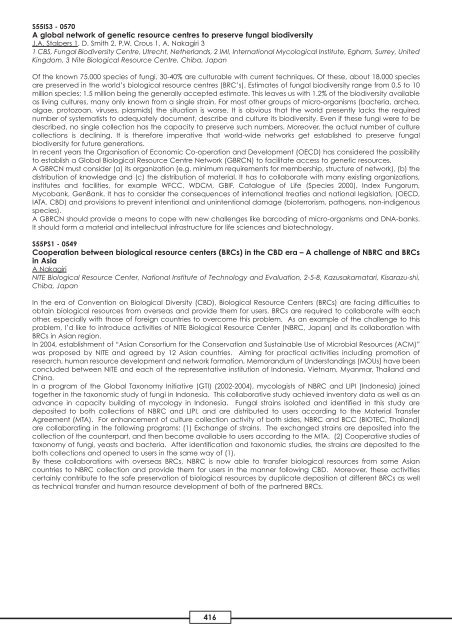Handbook Part 2 - International Mycological Association
Handbook Part 2 - International Mycological Association
Handbook Part 2 - International Mycological Association
Create successful ePaper yourself
Turn your PDF publications into a flip-book with our unique Google optimized e-Paper software.
S55IS3 - 0570<br />
A global network of genetic resource centres to preserve fungal biodiversity<br />
J.A. Stalpers 1, D. Smith 2, P.W. Crous 1, A. Nakagiri 3<br />
1 CBS, Fungal Biodiversity Centre, Utrecht, Netherlands, 2 IMI, <strong>International</strong> <strong>Mycological</strong> Institute, Egham, Surrey, United<br />
Kingdom, 3 Nite Biological Resource Centre, Chiba, Japan<br />
Of the known 75.000 species of fungi, 30-40% are culturable with current techniques. Of these, about 18.000 species<br />
are preserved in the world’s biological resource centres (BRC’s). Estimates of fungal biodiversity range from 0.5 to 10<br />
million species; 1.5 million being the generally accepted estimate. This leaves us with 1.2% of the biodiversity available<br />
as living cultures, many only known from a single strain. For most other groups of micro-organisms (bacteria, archea,<br />
algae, protozoan, viruses, plasmids) the situation is worse. It is obvious that the world presently lacks the required<br />
number of systematists to adequately document, describe and culture its biodiversity. Even if these fungi were to be<br />
described, no single collection has the capacity to preserve such numbers. Moreover, the actual number of culture<br />
collections is declining. It is therefore imperative that world-wide networks get established to preserve fungal<br />
biodiversity for future generations.<br />
In recent years the Organisation of Economic Co-operation and Development (OECD) has considered the possibility<br />
to establish a Global Biological Resource Centre Network (GBRCN) to facilitate access to genetic resources.<br />
A GBRCN must consider (a) its organization (e.g. minimum requirements for membership, structure of network), (b) the<br />
distribution of knowledge and (c) the distribution of material. It has to collaborate with many existing organizations,<br />
institutes and facilities, for example WFCC, WDCM, GBIF, Catalogue of Life (Species 2000), Index Fungorum,<br />
Mycobank, GenBank. It has to consider the consequences of international treaties and national legislation, (OECD,<br />
IATA. CBD) and provisions to prevent intentional and unintentional damage (bioterrorism, pathogens, non-indigenous<br />
species).<br />
A GBRCN should provide a means to cope with new challenges like barcoding of micro-organisms and DNA-banks.<br />
It should form a material and intellectual infrastructure for life sciences and biotechnology.<br />
S55PS1 - 0549<br />
Cooperation between biological resource centers (BRCs) in the CBD era – A challenge of NBRC and BRCs<br />
in Asia<br />
A Nakagiri<br />
NITE Biological Resource Center, National Institute of Technology and Evaluation, 2-5-8, Kazusakamatari, Kisarazu-shi,<br />
Chiba, Japan<br />
In the era of Convention on Biological Diversity (CBD), Biological Resource Centers (BRCs) are facing difficulties to<br />
obtain biological resources from overseas and provide them for users. BRCs are required to collaborate with each<br />
other, especially with those of foreign countries to overcome this problem. As an example of the challenge to this<br />
problem, I’d like to introduce activities of NITE Biological Resource Center (NBRC, Japan) and its collaboration with<br />
BRCs in Asian region.<br />
In 2004, establishment of “Asian Consortium for the Conservation and Sustainable Use of Microbial Resources (ACM)”<br />
was proposed by NITE and agreed by 12 Asian countries. Aiming for practical activities including promotion of<br />
research, human resource development and network formation, Memorandum of Understandings (MOUs) have been<br />
concluded between NITE and each of the representative institution of Indonesia, Vietnam, Myanmar, Thailand and<br />
China.<br />
In a program of the Global Taxonomy Initiative (GTI) (2002-2004), mycologists of NBRC and LIPI (Indonesia) joined<br />
together in the taxonomic study of fungi in Indonesia. This collaborative study achieved inventory data as well as an<br />
advance in capacity building of mycology in Indonesia. Fungal strains isolated and identified in this study are<br />
deposited to both collections of NBRC and LIPI, and are distributed to users according to the Material Transfer<br />
Agreement (MTA). For enhancement of culture collection activity of both sides, NBRC and BCC (BIOTEC, Thailand)<br />
are collaborating in the following programs: (1) Exchange of strains. The exchanged strains are deposited into the<br />
collection of the counterpart, and then become available to users according to the MTA. (2) Cooperative studies of<br />
taxonomy of fungi, yeasts and bacteria. After identification and taxonomic studies, the strains are deposited to the<br />
both collections and opened to users in the same way of (1).<br />
By these collaborations with overseas BRCs, NBRC is now able to transfer biological resources from some Asian<br />
countries to NBRC collection and provide them for users in the manner following CBD. Moreover, these activities<br />
certainly contribute to the safe preservation of biological resources by duplicate deposition at different BRCs as well<br />
as technical transfer and human resource development of both of the partnered BRCs.<br />
416









